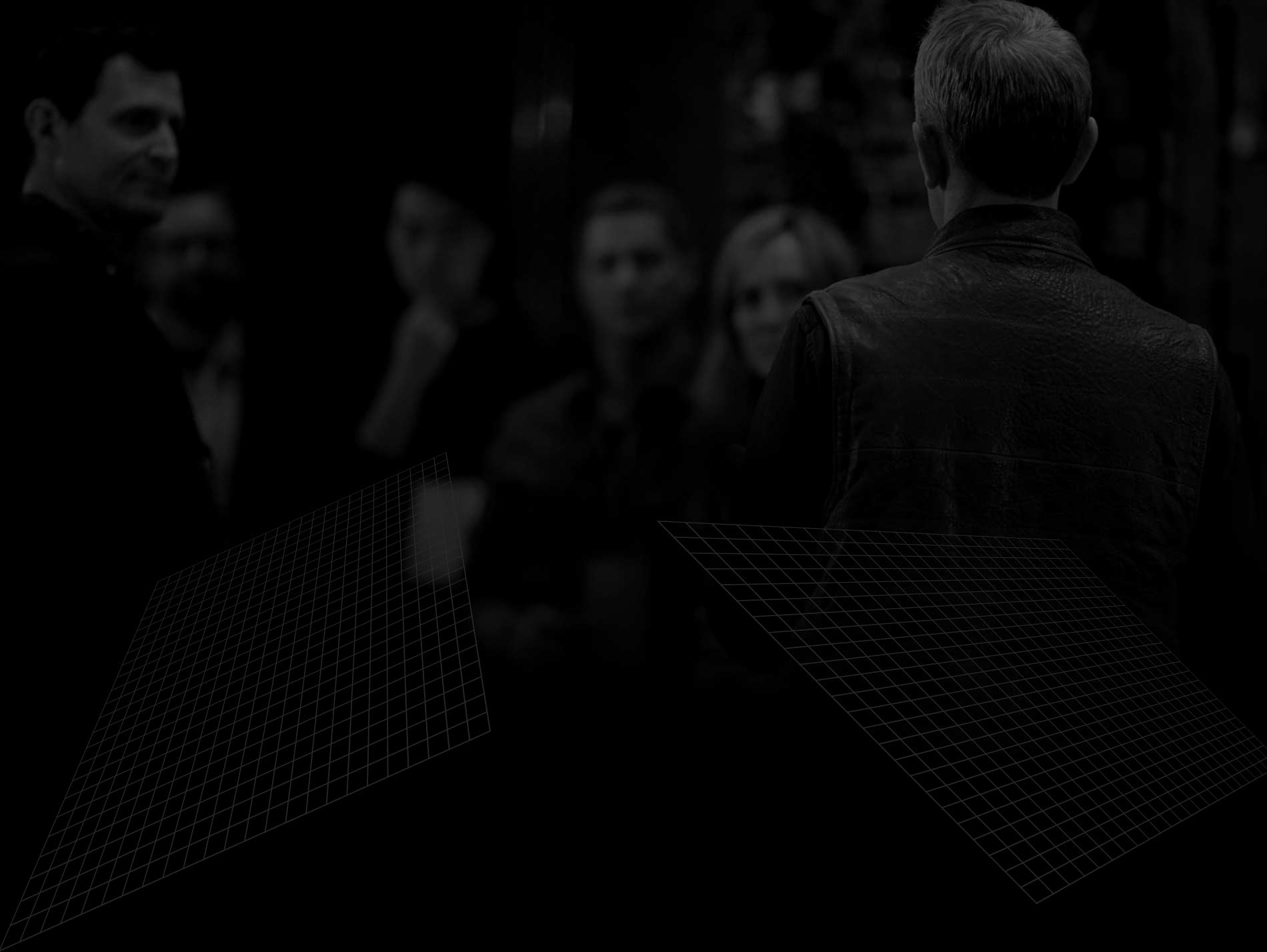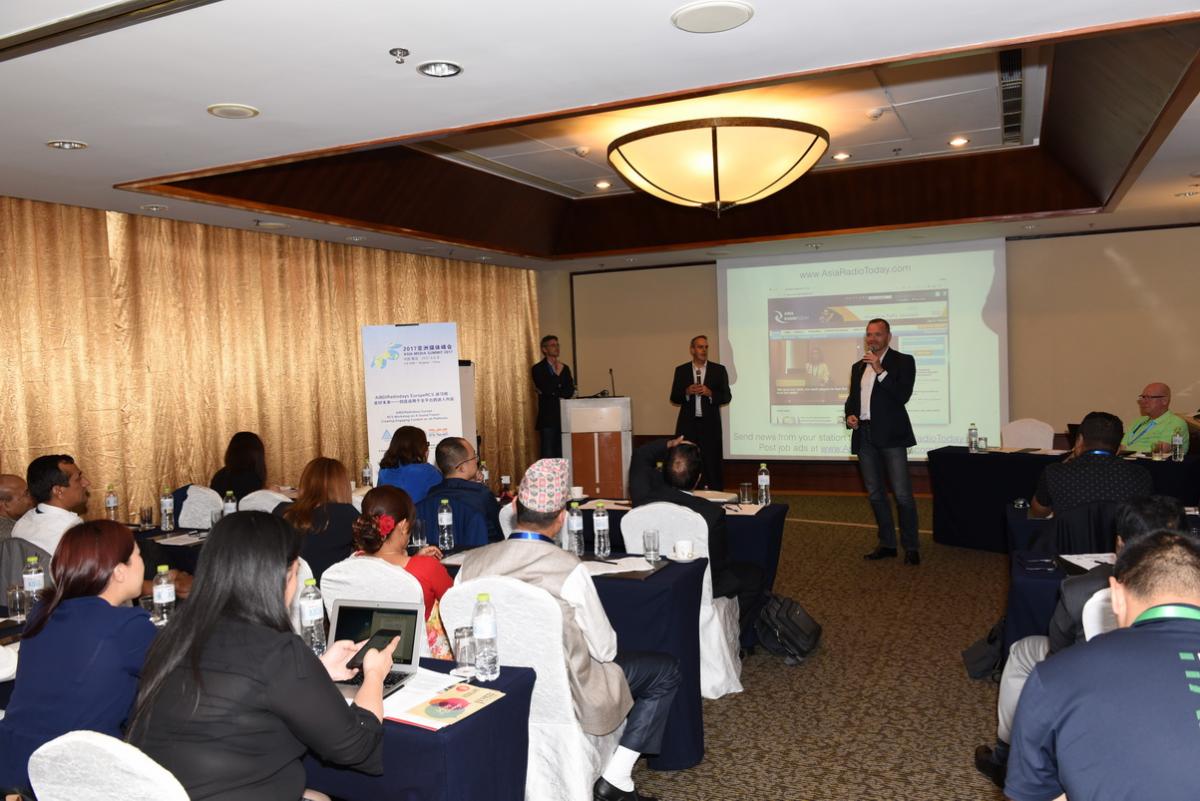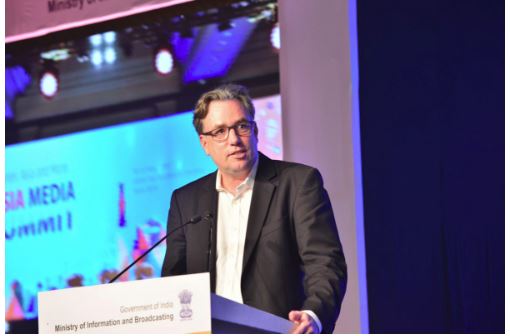The use of virtual studio and virtual studio implantation technology is bringing a new visual experience for the TV audience, and providing new thinking and creative new tools for television producers.
They are applications of the virtual reality technology and are becoming a new trend in the broadcast industry in Asia Pacific, Mr Huang Lei, Product Manager, Jetsen Technology Co. Ltd, Beijing, said in his presentation at a pre-summit regional workshop on augmented reality on 4 June 2017 in Qingdao, China. The workshop is a partnership among AIBD, Jetsen Technology Co., Whaley, and Bang Productions.
The use of virtual studio and virtual studio implantation technology is bringing a new visual experience for the TV audience, and providing new thinking and creative new tools for television producers.
They are applications of the virtual reality technology and are becoming a new trend in the broadcast industry in Asia Pacific, Mr Huang Lei, Product Manager, Jetsen Technology Co. Ltd, Beijing, said in his presentation at a pre-summit regional workshop on augmented reality on 4 June 2017 in Qingdao, China. The workshop is a partnership among AIBD, Jetsen Technology Co., Whaley, and Bang Productions.
Mr Huang highlighting the advantages of virtual studio technology and said it can easily replace the environment background and remove the repeated construction of a real scene. It can reduce costs and enhance quality of the programmes. He also said using virtual implantation technology in the virtual studio provides additional and brilliant effects to the programme, making them more impressive for audiences.
In his presentation, Huang discussed the development of four stages of the virtual reality technology. First is virtual reality (VR), a popular trend globally. Its most important sign is the use of a helmet or head mounted display, which allows the user to be fully surrounded by the virtual world. When he moves his head or walks around, he can see that the virtual world also moves, just like he is in the real world, but it’s not actually a real world, it’s just a virtual world.
The second stage is augmented reality (AR), which is also achieved by using a head mounted display equipment like the google glass. This allows the user to receive information and data from a real world while they observe the real world,which can help him in his work. For instance, when a user wears an AR glass, and comes across a dinning room, the glass will instantly show him the famous dishes and their prices as well. Huang said this kind of technology in the broadcasting industry becomes the virtual studio that we all know.
The third stage is the mixed reality (MR), which is the combination of VR and AR plus digital information. MR puts the virtual items into real world and allows the users to have interaction with those virtual items.
And the fourth stage is cinematic reality (CR), which he said is another form of mixed reality.
While admitting that most TV stations have their own virtual studio system, Huang said that they mostly stay in the production of 2D or 3D precept animations, a level that precludes any connection between the virtual contents and the hosts or even the interaction with the audiences.
But with the development of the motion capture system, he said ‘ this fills the void of interactivity in the virtual studio system and the interactivity of the programme has been further improved.”
Speaking about motion capture technology use in the broadcast industry, Huang said this technology is not a stand-alone system. Huang said motion capture technology can be integrated into the virtual studio system as a foreground signal, and with the combination with the camera tracking signal, the show can have a perfect virtual character standing right beside a real person to give the audience a live program.
By expanding production’s thinking in using motion capture system, broadcasters can have more income from the sponsors to better advertise their IP in the programme, without having annoying advertisement,and improve TV viewing experiences of viewers.

In his presentation, he cited the three compositions for a full motion capture system. These are the facial expression capture technology, the body capture part, and the finger motion capture system.
Other speakers in the pre-summit workshop were Caspar Sonne, Head of New Media/IDFA DocLab of the International Documentary Film Festival in Amsterdam, andVikramChanna, Vice President of Branded Content & Partnerships, Production & Commercial Partnerships of Discovery Networks in Asia- Pacific, Singapore.
MrSonne presented some outstanding interactive productions from the IDFA, emphasizing that various formats are emerging, but there is no real box yet. “ We need undefined spaces for playing, and for exploring,” he said.
Acknowledging that VR technology is one of the big developments in the last five years, Sonnesaidwe need to be careful in jumping on board or dismissing it. He also said that new interactive storytelling initiatives should work on a long-term basis, beyond five years to be able to attract funding.
Given the complexity of technology trends across the globe, Sonne said players in the old and new media must have a dialogue to understand today’s reality in which the digital and physical entities have become blurred. To ensure success, he suggested that interactive storytelling should be timeless, moving and must have fun.
MrChanna talked about Discovery Channel’s audience shift, now targeting 18-40 year old viewers, or so-called millennials and older millennials. This new strategy, he said, is transforming the way they deliver content in various platforms, they structure their organisation and adapt their organisational culture to changes in the media landscape.
He said they are coming out with new programmes with international partners that are enhancing their audience’ viewing experience. Equally important, he said, is that they are able to monetise these new shows even at the conceptualisation stage leveraging on the brand that Discovery channel has established through the years.
To maximise the opportunities from new technologies, Sonne and Vikram advised that organisations must set up an innovation department and that every department should be innovative.
Other speakers were Guo Song-Jie, CEO of WuBuWei (Beijing) Film & TV Technology Co. Ltd., who discussed the development and application of camera matrix technology for augmented reality, and FengYunWen, Technical Consultant of Auro Technology, who spoke on auro 3D in augmented reality application.
Enhancing Audiences Viewing Experience through Virtual Reality Technology
The use of virtual studio and virtual studio implantation technology is bringing a new visual experience for the TV audience, and providing new thinking and creative new tools for television producers.
They are applications of the virtual reality technology and are becoming a new trend in the broadcast industry in Asia Pacific, Mr Huang Lei, Product Manager, Jetsen Technology Co. Ltd, Beijing, said in his presentation at a pre-summit regional workshop on augmented reality on 4 June 2017 in Qingdao, China. The workshop is a partnership among AIBD, Jetsen Technology Co., Whaley, and Bang Productions.
Radio Stations Urged to Understand and Love their Listeners
A winning strategy for radio stations must consider the listener, brand. Content and promotion.
They must learn to understand and love their listeners who, after all, decide the shape of their brand. “ Everything a radio station does in the air must be entertaining, useful, interesting to their listeners, and connecting to their heart, head and hand,” says Francis Currie, international radio consultant, trainer and coach, UK. Mr Currie spoke at the AIBD/Radiodays Europe/RCS Presummit workshop on “A Sound Future-Creating Engaging Content on all Platforms, held on 5 June 2017 in Qingdao, China. Some 31 participants from 16 countries in Asia-Pacific and Africa attended the workshop.Constructive Journalism: Bringing Back Journalism to its Core Values
A new approach to deal with sensationalism and negativism in news that are increasingly turning off audiences and pushing them to trust media less and care less about the world is the application of constructive journalism. Constructive journalism can “ empower audiences to have an accurate view of the world and also learn about solutions, not just problems, what’s working and not just what’s not working” Mr Mark Egan, a mobile video specialist and faculty member of EuroVision Academy, said,
Should All Good Stories be Commercially Successful?
“Try to focus on humanizing and humorizing a story. If
Confirmed Speakers for AMS 2017
AIBD is pleased to confirm the following speakers for the Asia Media Summit to be held in Qingdao, China from 6 - 8 June 2017, and urge you to register online by 10th May 2017.
1. Speakers Confirmed
- Ms Jiang Hua, Director, News and Media Division, Department of Public Information, United Nations
- Dr Marielza Oliveira, Director and UNESCO Representative to the People’s Republic of China, the Democratic People’s Republic of Korea, Japan, Mongolia and the Republic of Korea
- Mr Shantha Retnasingam, Chief, Section for Mobilizing Resources from Multilateral and Private Partners, Bureau of strategic Planning, UNESCO
- Ms Valerie Cliff, UNDP Asia-Pacific Deputy Regional Director and Director of the Bangkok Regional Hub
- Hon. Mr Hasanul Haq Inu, MP, Minister of Information, Bangladesh
- H.E. Dr Pe Myint, Union Minister for Information, Ministry of Information, Republic of the Union of Myanmar
- Hon. Jose Ruperto Martin M. Andanar, Secretary, Presidential Communications Operations Office, Philippines
- H.E. Afamasaga Lepuiai Rico Tupai, Minister of Communications and Information Technology of the Indepenent State of Samoa
- Hon. Abdullahi Majeed, Minister of State for Environment and Energy, Maldives
- Hon. Ybhg. Dato’ Sri Dr Sharifah Zarah Syed Ahmad, Ministry of Communications and Multimedia, Malaysia
- Hon. Dato’ Seri Dr Chen Chaw Min, Secretary General, Ministry of Health, Malaysia
- Dr. Javad Mottaghi, Secretary-General, ABU
And many more..
2. Deadline for Registration for AMS
The deadline for AMS 2017 online registration is 10th May 2017. If you have not done this, please register online as soon as possible at the link here. Kindly note that Chinese Visa application may take at least 3 weeks.
Kind and Urgent Reminder AMS 2017
1. AMS Dates and Venue
AIBD is pleased to announce that the official dates and venue of Asia Media Summit 2017 will be June 6 - 8 at China Hall, Valley Wing Shangri-La Hotel, Qingdao, China. Several Pre-summit workshops will be held 4-5 June also at Shangri-La Hotel. There will be a designated alternative hotel for accommodation - Fuxin Hotel.
2. Deadline for Registration for AMS
AMS 2017 Online Registration Open
Online Registration
The Online registration for the Asia Media Summit (AMS) 2017, to be held from 6 to 8 June 2017 in Qingdao, China is now officially open. Please register using the link here.
We encourage all delegates to register as early as possible.
The deadline for registration is Monday, 10 May 2017.
AMS Venue
The AMS 2017 will be held at the Shangri-La Hotel, Qingdao, China.
AMS 2017 in Qingdao City, China
Next year’s Asia Media Summit will be held in China again, this time in Qingdao, a beautiful seaside city located in the southeast part of Shandong Province.
Mr Yan Chengsheng, Deputy Director General of the State Administration of Press, Publication, Radio, Film & Television, China, announced that China will host the 14th AMS in 2017 during the closing ceremony of the Asia Media Summit on 26 May 2016 in Incheon, Korea. He formally accepted AIBD’s offer to host the event from AIBD Director Chang Jin.
Demands of Cutting-edge Content
For broadcasters to develop and sustain cutting-edge content, they must ensure it is interactive and produced and delivered on multi-screens. Such content must cater to more young people and also be part of the whole industrial chain.
This advice came from Mr Lv Peng, President of Shandong TV, China, who participated in the CEO Roundtable at the 13th Asia Media Summit on 26 May 2016 in Incheon, Korea




